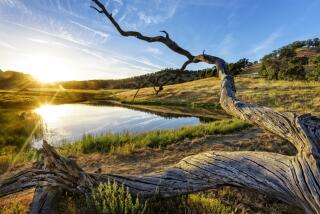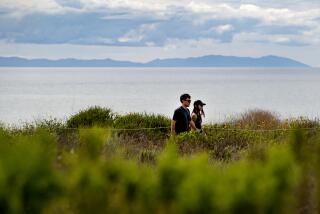Recreation Braces for Cutbacks : 3 O.C. State Parks Will Be Hard Hit; Reductions Likely in Hours, Services
Officials at three of Orange County’s most popular recreation areas--Crystal Cove State Park and Bolsa Chica and Huntington state beaches--are bracing for deep budget cuts that will likely force them to reduce hours of operation, close off some areas and slash services.
Officials say they are struggling to find ways to cope with California’s financial crisis without jeopardizing the parks’ natural resources or making them less enjoyable to the public.
“We have to cut personnel. That’s the long and short of it. (The cuts) will be substantial,” said Jack Roggenbuck, state parks superintendent for the Orange County coastal district.
California’s vast network of 285 state parks, which includes state beaches, is $30 million short of funds because of falling tax revenues and a miscalculation of funds generated by park fees. Last week, the state Parks and Recreation Department announced that it will close 15 historic parks for one or two days a week for the first time.
Although none of the closures are in Orange County, no state park will escape unscathed.
Roggenbuck said his 1991-92 budget for Orange County’s coastal state parks will likely be cut 15%. The full scope of the cutbacks will be known in January, and then staff will determine what services will be eliminated.
The cuts are expected to be deeply felt at Crystal Cove, Huntington and Bolsa Chica, the most popular state parks in the county with a combined 7.5 million visitors a year. Other state parks in Orange County that will also be struggling with budget cuts are Doheny and San Clemente state beaches and Chino Hills State Park.
“The department has been hit with cuts virtually every year I can remember,” Roggenbuck said. “We’ve always been able to lessen the impact by just deferring things, like painting a building. But you can only do that so long before everything falls apart and you’ve lost the significant investment the public has made.
“What we’re looking at now is a necessary reduction in services, and we don’t like it. The public is going to be able to see it.”
Park officials worry about adequately protecting Crystal Cove State Park, which has fragile tide pools and brushy habitat used by rare birds and animals. One growing problem in the park is that some reckless mountain bikers are tearing up the terrain and endangering hikers on the trails.
“Certainly there is a degree of fear on my part that we will see (those problems increase),” Roggenbuck said. “Our mission is varied in its purposes, so it’s not an easy decision to make--what to cut. We have to protect the park from the people as well as protect the people from the park.”
Crystal Cove--a 3,000-acre expanse with historic buildings built in the 1930s, rocky beaches, spectacular ocean views and rolling coastal hills full of wildlife--currently has 11 year-round, full-time workers. That’s about one for every 100,000 visitors who arrive annually.
Huntington and Bolsa Chica state beaches--almost 5 miles of coastline popular for beach barbecues and family outings--have a combined full-time staff of about 50 to handle more than 6 million visitors. Huntington State Beach is the most popular state park in California, and rangers say the challenge there is to ensure that it is not overrun with litter and crime.
At peak times, the staff for the entire three-park district reaches about 300 workers.
Park employees are nervous about the expected cuts, worrying that it might mean layoffs.
“In all the years I’ve worked for the state, I’ve never seen it this bad,” said David Ruger, a Crystal Cove park ranger who has worked there since 1984.
“It’s anybody’s guess what will happen, and it’s an uneasy feeling people have here. Some people who don’t have a lot of seniority wonder if they’re going to have a job next year,” Ruger said. “If we lose staff, we probably won’t be able to fill the openings, and it puts more stress on those people who are left behind to run the fort, so to speak.”
The cuts will be felt in state parks throughout Southern California, where seasonal help for the 1991-92 year already has been cut by 22%.
“Obviously a cut of that size is pretty deep. It’s yet to be seen how we are going to cope with it,” said George Cook, deputy regional director for the park department’s southern region, which stretches from Ventura County to the Mexican border. “We’re hoping we can provide a reasonable service level, but it won’t be what people are used to.”
One change that is considered likely is closing parks earlier or opening them later. The cuts will probably mean people cannot use their state parks during some daylight hours, since the current hours are 6 a.m. to sundown at Crystal Cove and 6 a.m. to 8 p.m. at the two state beaches.
Also, some areas of the three state facilities might be shut down to visitors, and some washrooms and parking lots may be closed, Roggenbuck said.
The number of rangers and maintenance workers is likely to shrink. Some lifeguard stations might close, too, although Roggenbuck said service is a priority and will probably experience the least cuts.
The parks office hopes to reduce services only during the off-season, keeping the staffing and hours as close to normal as possible during the hectic summer months.
“We’re looking at hopefully being able to do it on the fringes of the heavy-use period,” Roggenbuck said. “For example, instead of full lifeguard service in the early spring for Easter, we might staff every other station.”
Roggenbuck warned that the combination of budget woes could lead to such changes as a ban on mountain bikes in the backcountry of Crystal Cove State Park. He said bicyclists do not pay fees to use the trails, yet damage inflicted by some riders creates time-consuming problems for the park’s staff.
“At Crystal Cove, our primary objective is to preserve the natural and cultural features unique to that park. Recreation is secondary,” he said.
Officials predict that park system’s budget problems will probably get worse. The parks are required by the Legislature to get 60% of their funds from fees, but Roggenbuck said any further increases in the rates--now $5 and $6 for parking--will only serve to chase people away in search of cheaper recreation.
Park officials have put out a desperate plea to the public: Help take care of the parks because the state caretakers can no longer do it themselves.
“If the public understands that these cuts are short-term and cooperates with us and doesn’t go into a closed area or trample over gnatcatcher habitat, then I don’t see significant impact to the resources,” Roggenbuck said.
More to Read
Sign up for Essential California
The most important California stories and recommendations in your inbox every morning.
You may occasionally receive promotional content from the Los Angeles Times.










